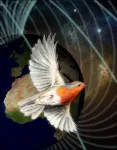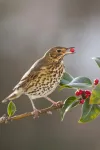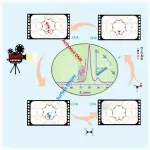Quantum birds
International team of researchers shed light on the mechanism of magnetic sensing in birds
2021-06-23
(Press-News.org) Humans perceive the world around them with five senses - vision, hearing, taste, smell and touch. Many other animals are also able to sense the Earth's magnetic field. For some time, a collaboration of biologists, chemists and physicists centred at the Universities of Oldenburg (Germany) and Oxford (UK) have been gathering evidence suggesting that the magnetic sense of migratory birds such as European robins is based on a specific light-sensitive protein in the eye. In the current edition of the journal Nature, this team demonstrate that the protein cryptochrome 4, found in birds' retinas, is sensitive to magnetic fields and could well be the long-sought magnetic sensor.
First author Jingjing Xu, a doctoral student in Henrik Mouritsen's research group in Oldenburg, took a decisive step toward this success. After extracting the genetic code for the potentially magnetically sensitive cryptochrome 4 in night-migratory European robins, she was able, for the first time, to produce this photoactive molecule in large quantities using bacterial cell cultures. Christiane Timmel's and Stuart Mackenzie's groups in Oxford then used a wide range of magnetic resonance and novel optical spectroscopy techniques to study the protein and demonstrate its pronounced sensitivity to magnetic fields.
The team also deciphered the mechanism by which this sensitivity arises - another important advance. "Electrons that can move within the molecule after blue-light activation play a crucial role", explains Mouritsen. Proteins like cryptochrome consist of chains of amino acids: robin cryptochrome 4 has 527 of them. Oxford's Peter Hore and Oldenburg physicist Ilia Solov'yov performed quantum mechanical calculations supporting the idea that four of the 527 - known as tryptophans - are essential for the magnetic properties of the molecule. According to their calculations, electrons hop from one tryptophan to the next generating so-called radical pairs which are magnetically sensitive. To prove this experimentally, the team from Oldenburg produced slightly modified versions of the robin cryptochrome, in which each of the tryptophans in turn was replaced by a different amino acid to block the movement of electrons.
Using these modified proteins, the Oxford chemistry groups were able to demonstrate experimentally that electrons move within the cryptochrome as predicted in the calculations - and that the generated radical pairs are essential to explain the observed magnetic field effects.
The Oldenburg team also expressed cryptochrome 4 from chickens and pigeons. When studied in Oxford, the proteins of these species, which do not migrate, exhibit similar photochemistry to that of the migratory robin, but appear markedly less magnetically sensitive.
"We think these results are very important because they show for the first time that a molecule from the visual apparatus of a migratory bird is sensitive to magnetic fields" says Mouritsen. But, he adds, this is not definitive proof that cryptochrome 4 is the magnetic sensor the team is looking for. In all experiments, the researchers examined isolated proteins in the laboratory. The magnetic fields used were also stronger than the Earth's magnetic field. "It therefore still needs to be shown that this is happening in the eyes of birds" Mouritsen stresses. Such studies are not yet technically possible.
However, the authors think the proteins involved could be significantly more sensitive in their native environment. In cells in the retina, the proteins are probably fixed and aligned, increasing their sensitivity to the direction of the magnetic field. Moreover, they are also likely to be associated with other proteins that could amplify the sensory signals. The team is currently searching for these as yet unknown interaction partners.
Hore says "if we can prove that cryptochrome 4 is the magnetic sensor we will have demonstrated a fundamentally quantum mechanism that makes animals sensitive to environmental stimuli a million times weaker than previously thought possible".
INFORMATION:
The cooperation between Oldenburg and Oxford is funded by a 6-year Synergy Grant from the European Research Council (ERC) with the title 'QuantumBirds'. The collaboration is also a key part of the Collaborative Research Center, 'Magnetoreception and Navigation in Vertebrates' (SFB 1372) funded by the German Research Foundation (DFG), and Ilia Solov'yov is a Lichtenberg Professor funded by the VolkswagenStiftung.
[Attachments] See images for this press release:

ELSE PRESS RELEASES FROM THIS DATE:
2021-06-23
Researchers rescued mice from early death caused by a muscle-weakening disease, not by correcting the flawed gene that causes it, but instead by targeting another protein in the same signaling pathway.
Led by NYU Grossman School of Medicine researchers, a new study found that an antibody treatment not only rescued young mice from a form of congenital myasthenia (CM) but also reversed disease relapse in adult mice.
Published online in the journal Nature on June 23, the study revealed new details of the cause of CM, with the better understanding guiding ...
2021-06-23
ITHACA, N.Y. - Scientists at Cornell University and the American Museum of Natural History have identified 2,034 nearby star-systems - within the small cosmic distance of 326 light-years - that could find Earth merely by watching our pale blue dot cross our sun.
That's 1,715 star-systems that could have spotted Earth since human civilization blossomed about 5,000 years ago, and 319 more star-systems that will be added over the next 5,000 years.
Exoplanets around these nearby stars have a cosmic front-row seat to see if Earth holds life, the scientists said in research published June 23 in Nature.
"From the exoplanets' point-of-view, we are the aliens," said Lisa Kaltenegger, professor of astronomy and director of Cornell's Carl Sagan ...
2021-06-23
What The Study Did: Hospital employees were surveyed about symptoms such as a rash, itching, hives or swelling around the face after receiving a messenger RNA COVID-19 vaccine.
Authors: Lacey B. Robinson, M.D., M.P.H., of Massachusetts General Hospital in Boston, is the corresponding author.
To access the embargoed study: Visit our For The Media website at this link https://media.jamanetwork.com/
(doi:10.1001/jamadermatol.2021.2114)
Editor's Note: The article includes conflicts of interest and funding/support disclosures. Please see the article for additional information, including other authors, ...
2021-06-23
BOSTON - Skin problems such as itchiness, rashes, hives and swelling can occur in some individuals after receiving a COVID-19 vaccine, but it's not clear how common these reactions are or how frequently they recur with a subsequent vaccination. Research by led by allergists at Massachusetts General Hospital (MGH) now provides encouraging indications that the reactions are rare, and that even when they do occur with an initial COVID-19 vaccination, they seldom recur after receiving a second vaccine dose.
For the study, which is published in
JAMA Dermatology, a team led by Kimberly G. Blumenthal, MD, MSc, co-director of the Clinical Epidemiology Program within MGH's ...
2021-06-23
What The Study Did: Researchers investigated the association between counties that adopted state mask mandates in Kansas with COVID-19 cases, hospitalizations and deaths.
Authors: Donna K. Ginther, Ph.D., of the University of Kansas in Lawrence, is the corresponding author.
To access the embargoed study: Visit our For The Media website at this link https://media.jamanetwork.com/
(doi:10.1001/jamanetworkopen.2021.14514)
Editor's Note: The article includes funding/support disclosures. Please see the article for additional information, including other authors, author contributions ...
2021-06-23
What The Study Did: The hours worked and patterns of work activities among U.S. physicians before and during the COVID-19 pandemic were examined in this study.
Authors: Xiaochu Hu, Ph.D., of the Association of American Medical Colleges in Washington, D.C., is the corresponding author.
To access the embargoed study: Visit our For The Media website at this link https://media.jamanetwork.com/
(doi:10.1001/jamanetworkopen.2021.14386)
Editor's Note: Please see the article for additional information, including other authors, author contributions and affiliations, conflict ...
2021-06-23
What The Study Did: Researchers examined family voucher-based kidney donations and the capability of voucher redemption to provide timely kidney transplants.
Authors: Jeffrey L. Veale, M.D., of the University of California, Los Angeles, is the corresponding author.
To access the embargoed study: Visit our For The Media website at this link https://media.jamanetwork.com/
(doi:10.1001/jamasurg.2021.2375)
Editor's Note: The article includes conflict of interest disclosures. Please see the article for additional information, including other authors, author contributions and affiliations, conflict of interest and ...
2021-06-23
Migratory birds carry most seeds in the wrong direction to help plants cope with climate change, new research shows.
The study, published in Nature, reveals that the vast majority of plants from European woodlands are dispersed by birds migrating to warmer latitudes in the south, while far fewer are dispersed by birds migrating north.
As a consequence of global warming, the optimal climatic conditions of species are moving towards cooler latitudes, forcing the redistribution of life on Earth.
Mobility allows many animals to reach new areas with a suitable climate.
However, movement of plant species depends on the dispersal of their seeds at long ...
2021-06-23
CHAPEL HILL, NC--Researchers at the University of North Carolina at Chapel Hill and the UNC Lineberger Comprehensive Cancer Center have uncovered a new mechanism that activates specific genes, leading to the development of cancers.
They showed that a mutation that fuses two unrelated genes can promote a process similar to that observed when oil and water are mixed but do not blend together. The process, called liquid-liquid phase separation, occurs inside a cell's nucleus and enables the formation of compartments with various physical properties that can promote cancers such as acute leukemias. Their findings will be published online June 23, 2021, in Nature.
"Phase separation and its role in cancer has been a missing puzzle piece in understanding this disease," said UNC Lineberger's ...
2021-06-23
A joint research team led by Prof. LIU Zhongmin, Prof. WEI Yingxu, and Prof. XU Shutao from the Dalian Institute of Chemical Physics (DICP) of the Chinese Academy of Sciences (CAS) revealed the mechanism underlying the formation of the first carbon-carbon (C-C) bond formation during the methanol-to-olefins (MTO) process.
This study was published in Chem on June 23.
Prof. ZHENG Anmin's group from Innovation Academy for Precision Measurement Science and Technology of CAS was also involved in the study.
The first C-C bond in the MTO process is formed at the initial stage of the reaction. There is no direct method to elucidate the bond formation /reaction mechanism due to the difficulty in capturing intermediate species.
"We investigated the ...
LAST 30 PRESS RELEASES:
[Press-News.org] Quantum birds
International team of researchers shed light on the mechanism of magnetic sensing in birds



